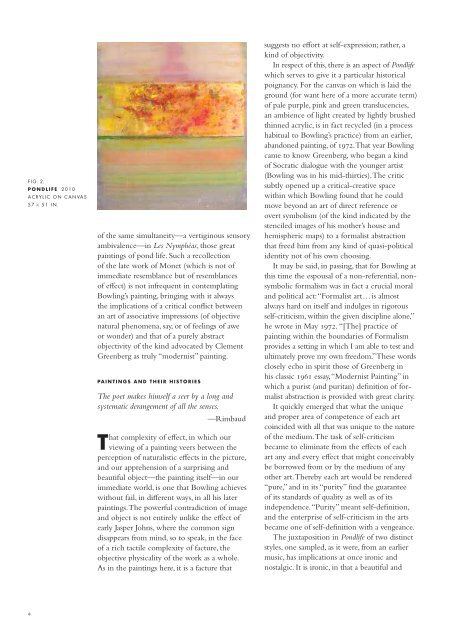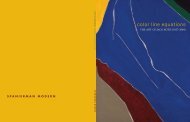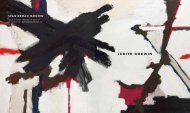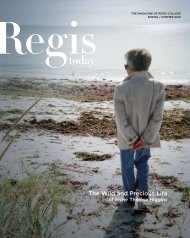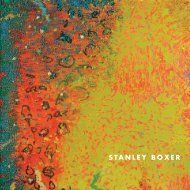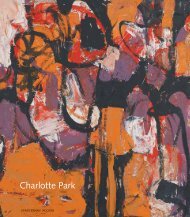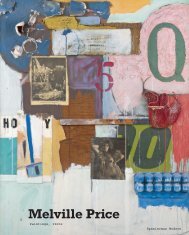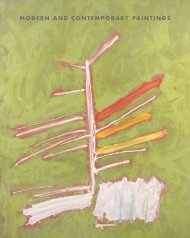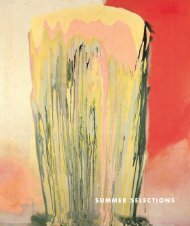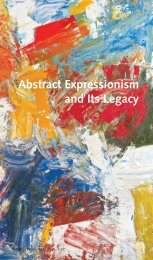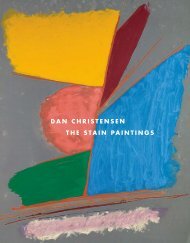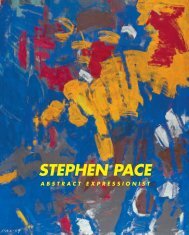View the catalogue - Spanierman Modern
View the catalogue - Spanierman Modern
View the catalogue - Spanierman Modern
You also want an ePaper? Increase the reach of your titles
YUMPU automatically turns print PDFs into web optimized ePapers that Google loves.
FIG. 2.<br />
PONDLIFE 2010<br />
ACRYLIC ON CANVAS<br />
57 51 IN.<br />
of <strong>the</strong> same simultaneity—a vertiginous sensory<br />
ambivalence—in Les Nymphéas, those great<br />
paintings of pond life. Such a recollection<br />
of <strong>the</strong> late work of Monet (which is not of<br />
immediate resemblance but of resemblances<br />
of effect) is not infrequent in contemplating<br />
Bowling’s painting, bringing with it always<br />
<strong>the</strong> implications of a critical conflict between<br />
an art of associative impressions (of objective<br />
natural phenomena, say, or of feelings of awe<br />
or wonder) and that of a purely abstract<br />
objectivity of <strong>the</strong> kind advocated by Clement<br />
Greenberg as truly “modernist” painting.<br />
PAINTINGS AND THEIR HISTORIES<br />
The poet makes himself a seer by a long and<br />
systematic derangement of all <strong>the</strong> senses.<br />
—Rimbaud<br />
That complexity of effect, in which our<br />
viewing of a painting veers between <strong>the</strong><br />
perception of naturalistic effects in <strong>the</strong> picture,<br />
and our apprehension of a surprising and<br />
beautiful object—<strong>the</strong> painting itself—in our<br />
immediate world, is one that Bowling achieves<br />
without fail, in different ways, in all his later<br />
paintings. The powerful contradiction of image<br />
and object is not entirely unlike <strong>the</strong> effect of<br />
early Jasper Johns, where <strong>the</strong> common sign<br />
disappears from mind, so to speak, in <strong>the</strong> face<br />
of a rich tactile complexity of facture, <strong>the</strong><br />
objective physicality of <strong>the</strong> work as a whole.<br />
As in <strong>the</strong> paintings here, it is a facture that<br />
suggests no effort at self-expression; ra<strong>the</strong>r, a<br />
kind of objectivity.<br />
In respect of this, <strong>the</strong>re is an aspect of Pondlife<br />
which serves to give it a particular historical<br />
poignancy. For <strong>the</strong> canvas on which is laid <strong>the</strong><br />
ground (for want here of a more accurate term)<br />
of pale purple, pink and green translucencies,<br />
an ambience of light created by lightly brushed<br />
thinned acrylic, is in fact recycled (in a process<br />
habitual to Bowling’s practice) from an earlier,<br />
abandoned painting, of 1972. That year Bowling<br />
came to know Greenberg, who began a kind<br />
of Socratic dialogue with <strong>the</strong> younger artist<br />
(Bowling was in his mid-thirties). The critic<br />
subtly opened up a critical-creative space<br />
within which Bowling found that he could<br />
move beyond an art of direct reference or<br />
overt symbolism (of <strong>the</strong> kind indicated by <strong>the</strong><br />
stenciled images of his mo<strong>the</strong>r’s house and<br />
hemispheric maps) to a formalist abstraction<br />
that freed him from any kind of quasi-political<br />
identity not of his own choosing.<br />
It may be said, in passing, that for Bowling at<br />
this time <strong>the</strong> espousal of a non-referential, nonsymbolic<br />
formalism was in fact a crucial moral<br />
and political act: “Formalist art. . . is almost<br />
always hard on itself and indulges in rigorous<br />
self-criticism, within <strong>the</strong> given discipline alone,”<br />
he wrote in May 1972. “[The] practice of<br />
painting within <strong>the</strong> boundaries of Formalism<br />
provides a setting in which I am able to test and<br />
ultimately prove my own freedom.” These words<br />
closely echo in spirit those of Greenberg in<br />
his classic 1961 essay, “<strong>Modern</strong>ist Painting” in<br />
which a purist (and puritan) definition of formalist<br />
abstraction is provided with great clarity.<br />
It quickly emerged that what <strong>the</strong> unique<br />
and proper area of competence of each art<br />
coincided with all that was unique to <strong>the</strong> nature<br />
of <strong>the</strong> medium. The task of self-criticism<br />
became to eliminate from <strong>the</strong> effects of each<br />
art any and every effect that might conceivably<br />
be borrowed from or by <strong>the</strong> medium of any<br />
o<strong>the</strong>r art. Thereby each art would be rendered<br />
“pure,” and in its “purity” find <strong>the</strong> guarantee<br />
of its standards of quality as well as of its<br />
independence. “Purity” meant self-definition,<br />
and <strong>the</strong> enterprise of self-criticism in <strong>the</strong> arts<br />
became one of self-definition with a vengeance.<br />
The juxtaposition in Pondlife of two distinct<br />
styles, one sampled, as it were, from an earlier<br />
music, has implications at once ironic and<br />
nostalgic. It is ironic, in that a beautiful and<br />
4


